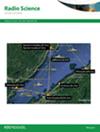Consistency of the troposphere wet delay from water vapor radiometer and co-located GPS station
IF 1.6
4区 地球科学
Q3 ASTRONOMY & ASTROPHYSICS
引用次数: 0
Abstract
The tropospheric delay acquired by the Global Navigation Position System (GPS) Precise Point Positioning (PPP) is continuous and steady, less affected by rainfall. The Water Vapor Radiometer (WVR) can provide real-time meteorological parameters but is more sensitive to high-frequency information in troposphere. To explore the use of WVR-retrieved tropospheric delay and assist other geodetic techniques for atmospheric correction, the tropospheric delay from WVR and co-located GPS at Shanghai, Beijing, Kunming, and Urumqi stations in China are compared. For the inconsistent values of WVR-PPP zenith wet delay, the variations of the tropospheric delay from WVR and GPS before and after the rainfall were statistically analyzed. The results suggest that, for the rain rate ranging from 0.1 to 50 mm/hr, the impact of rainfall on WVR could last from 10 min before to 30 min after the rainfall. With filtering WVR data based on meteorological parameters and rain rate, the zenith wet delay between WVR and PPP at Shanghai shows good consistency, the root mean square (RMS) is 6.11 mm, correlation is 0.997, and the RMS in the other three stations ranges from 16.35 to 25.16 mm (correlation ranges in 0.794–0.951). The analysis indicates that the tropospheric delay of WVR is reliable to be applied to space geodetic techniques correction in real-time with filtering to reduce the effect of rainfall, water vapor, and liquid water variability.水汽辐射计和共址 GPS 站对流层湿延迟的一致性
全球导航定位系统(GPS)精确点定位(PPP)获得的对流层延迟是连续稳定的,受降雨的影响较小。水汽辐射计(WVR)可提供实时气象参数,但对对流层高频信息更为敏感。为了探索如何利用水汽辐射计获取的对流层延迟并辅助其他大地测量技术进行大气校正,我们对中国上海、北京、昆明和乌鲁木齐站的水汽辐射计和共址全球定位系统获取的对流层延迟进行了比较。针对 WVR-PPP 天顶湿延迟值不一致的情况,对降雨前后 WVR 和 GPS 对流层延迟的变化进行了统计分析。结果表明,在降雨率为 0.1 至 50 毫米/小时的情况下,降雨对 WVR 的影响可从降雨前 10 分钟持续到降雨后 30 分钟。根据气象参数和降雨率对 WVR 数据进行筛选,上海站 WVR 与 PPP 的天顶湿延迟一致性较好,均方根值为 6.11 mm,相关性为 0.997,其他三个站的均方根值在 16.35 至 25.16 mm 之间(相关性在 0.794-0.951 之间)。分析表明,WVR 的对流层延迟经过滤后可用于实时空间大地测量技术校正,以减少降雨、水汽和液态水变化的影响。
本文章由计算机程序翻译,如有差异,请以英文原文为准。
求助全文
约1分钟内获得全文
求助全文
来源期刊

Radio Science
工程技术-地球化学与地球物理
CiteScore
3.30
自引率
12.50%
发文量
112
审稿时长
1 months
期刊介绍:
Radio Science (RDS) publishes original scientific contributions on radio-frequency electromagnetic-propagation and its applications. Contributions covering measurement, modelling, prediction and forecasting techniques pertinent to fields and waves - including antennas, signals and systems, the terrestrial and space environment and radio propagation problems in radio astronomy - are welcome. Contributions may address propagation through, interaction with, and remote sensing of structures, geophysical media, plasmas, and materials, as well as the application of radio frequency electromagnetic techniques to remote sensing of the Earth and other bodies in the solar system.
 求助内容:
求助内容: 应助结果提醒方式:
应助结果提醒方式:


